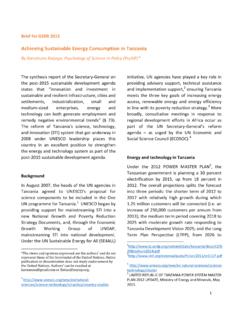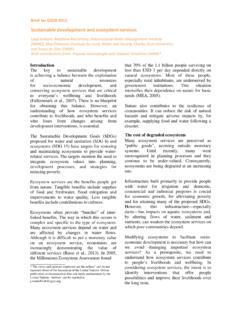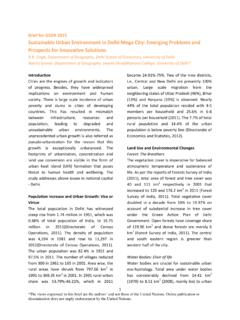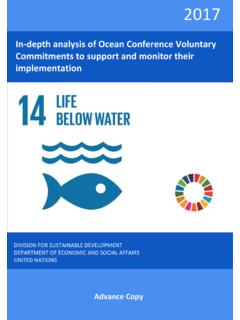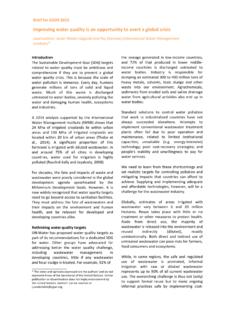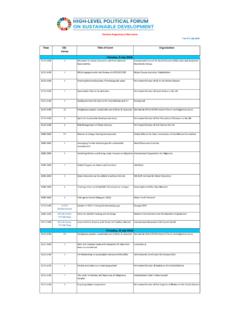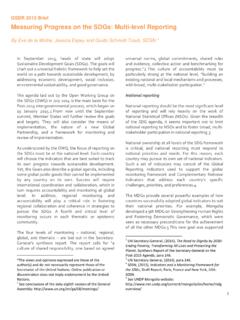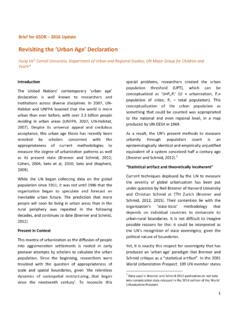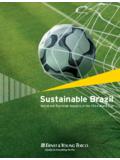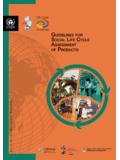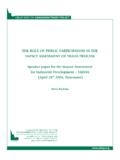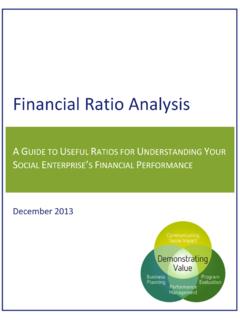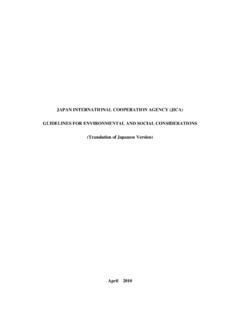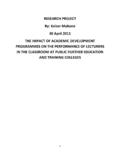Transcription of Integrated simulation models for sustainable …
1 1 GSDR 2015 Brief Integrated simulation models for sustainable agriculture policy design By Gunda Zuellicha, Kaveh Dianatia, Steve Arquitta, Matteo Pedercinia, Millennium Institute, Washington , USA* Introduction Despite significant gains over the past decade, rural poverty, food and nutrition insecurity and environmental degradation remain pervasive problems in the developing world. It is estimated that approximately 805 million people worldwide suffer from hunger and approximately billion live in extreme poverty (IFAD, 2010). Developing coherent plans to combat these problems is complicated by the multi-disciplinary, interconnected and complex nature of the systems that must be managed. Therefore, it is imperative that the strategies developed to tackle these issues are based on comprehensive and sound analyses addressing their key dimensions in an Integrated manner (UN, 1992; UN, 2000; UN, 2014a; UN, 2014b). The Threshold 21 (T21) simulation model supports such an approach (UNEP, 2014).
2 T21 is an Integrated and dynamic planning tool that enables transparent cross-sectoral analyses of the impacts of policies and enables exploration of their long-term consequences on social, economic and environmental development (Pedercini et al, 2010). T21 takes into account interdependency across sectors and is based on the vast collective knowledge gathered in multistakeholder processes. This makes it an effective tool for achieving a collectively shared understanding of problems, structures and solutions thus contributing to policy dialogue (Pedercini, 2005). When addressing food and nutrition insecurity, poverty and the degradation of environmental resources, it is important to note the key role that agriculture plays (IAASTD, 2009). While exerting significant pressure on environmental resources, agriculture directly contributes to food supply as well as to poor households income. More than 70 percent of the people living in extreme poverty worldwide live in rural areas and over 80 per cent of rural households are involved in farming activities (IFAD, 2010).
3 Therefore, under the Changing Course in Global agriculture (CCGA)1 project, the T21 model has been applied to analyse the cross-sectoral long term impacts of governmental support for adoption and diffusion of different agricultural practices in Senegal, Kenya, and Swaziland. This brief summarizes and compares the results from policy analyses carried out to identify common traits and differences that can provide further insights for effective policy design in these and other countries. The results demonstrate the need for a paradigm shift in agricultural development policy towards supporting training and investment in low external input farming techniques, adjusting existing development targets, and for Integrated , country-specific analyses to be performed in each country in order to assess the impact of these and other policies before implementation (Millennium Institute, 2014). Empirical Analysis Based on the T21 model developed by the Millennium Institute (Barney, 2002) each of the T21 country models has been adapted to *The views and opinions expressed are the authors and do not represent those of the Secretariat of the United Nations.
4 Online publication or dissemination does not imply endorsement by the United Nations. Corresponding author: 1 CCGA is a joint project of Millennium Institute and Biovision Foundation, financed among others by the International Fund for Agricultural Development and the Swiss Agency for Development and Cooperation, and implemented in collaboration with the Ministry of agriculture (Senegal, Kenya and Swaziland). 2 country-specific conditions in collaboration with national government agencies. The refinement of the models on issues related to agriculture , rural poverty, and food and nutrition security was guided and informed by the input of representatives from relevant stakeholder groups. In our analyses we first compare two scenarios representing two competing paradigms in agricultural policy and farming practices (FAO/OECD, 2011; IIASA/FAO, 2010). In the high external input and large-scale farming scenario (HEI + large-scale) the government mainly supports an agricultural production system characterized by intensive use of inputs such as chemical pesticides and synthetic fertilizers.
5 In the low external input and small-scale farming scenario (LEI + small-scale), the government supports farming practices characterized by low use of chemical products, high labour, and high agro-ecological knowledge intensity. The conclusions of the cross-country analysis of these scenarios are threefold (Millennium Institute, 2014). First, our analysis indicates that there is a high degree of similarity in the trends and patterns of response to the policies tested in the three countries. simulation results show that in all three countries agriculture production in both the above scenarios increases significantly over time compared to the Base Run scenario (continuation of current policies). Increased production results from higher applications of external inputs (in the HEI + large-scale scenario), and from diffusion of ecological agriculture techniques that lead to higher nutrient density in the soil and lower pest density (in the LEI + small-scale scenario).
6 However, in each country, simulations reveal that support for small-scale LEI farming has a greater positive impact on rural employment, poverty alleviation and food security. Furthermore, the small-scale LEI agricultural system demonstrates greater resilience when subjected to external shocks, such as fertilizer price increase, and proves to be more sustainable in the long term. Despite the better results eventually obtained in the LEI + small-scale scenario, the increase in production in that scenario is less pronounced in the short term than in the HEI + large-scale scenario (a worse-before-better behaviour). Such non-linear dynamics might mistakenly lead decision makers to choose the policy option with the better results in the short run, rather than the more sustainable and resilient policy option. Figure 1: Crops production in Senegal Figure 2 Selected Indicators for High external input + large-scale (red), Low external input + small-scale (green) scenarios in 2035 as % compared to Base Run 1357198019902000201020202030 Million TonsCrops ProductionLEI + small scaleHEI + large scaleBase RunData3 Figure 1 shows the behaviour over time in Senegal while Figure 2 summarizes the results for a set of key indicators.
7 The analysis of simulation results for the three countries converge in indicating the need for a paradigm shift in public policy for agricultural development in order to effectively address food and nutrition security, and poverty. The similarities in impact of the policies tested indicate that their implementation is likely to bring positive results in other countries in the region as well. Secondly, we tested agricultural policies in each country and assessed the extent to which targets set in current agricultural strategies can be achieved. Our analysis shows that in all three countries several of the targets for mid- to long-term agriculture development, food and nutrition security and rural poverty alleviation specified in current strategic and investment plans are overly ambitious. Setting ambitious targets can be effective in creating momentum for change. Such momentum, however, might change to frustration in cases where targets are so ambitious that even very considerable improvements fall short of the stated target.
8 Implementation of effective policies thus may also imply a need for adjusting existing development targets based on a comprehensive and Integrated analysis. Thirdly, the analysis reveals that despite the mentioned similarities of results there are important structural differences in the three countries that lead to different impacts of the policies tested. These include differences in government budget shares for agriculture , in existing room for improvement in yields, in the importance of the agriculture sector, and in the level of subsidies. For example, when examining the impact of external shocks on fertilizer prices, we found that the impact on crop production was milder in countries with a higher level of subsidies for mineral fertilizer. On the other hand, when we looked at the impact of reduced public support for the agriculture sector, we found that the impact on crop production was greater in countries with a higher level of subsidies for mineral fertilizer, thus highlighting the dependence on governmental support associated with such subsidy policies.
9 These differences emphasize the importance of considering the specific context in which agricultural policies are introduced. A strategy that ignores country specific circumstances such as culture, socio-economic conditions, and the very diverse agricultural landscape of sub-Saharan Africa cannot be fully effective. Therefore, our findings call for country-specific analyses to be performed also in other countries in order to assess the impact of policies before implementation. System dynamics simulation models such as T21 can facilitate holistic and Integrated country-specific analysis, assess the ability of alternative policies to achieve given socio-economic goals, and support the realization of paradigm shifts by providing decision makers with critical information on the long-term multi-sectoral impacts of proposed policies and strategies. Issues for consideration The following are recommendations for policy-makers: Promote the use of Integrated simulation models such as T21 for country-specific policy analysis Support the training and investment in low external input farming techniques Promote the use of quantitative tools for achieving and measuring development targets References Barney, (2002).
10 The Global 2000 Report to the President and the Threshold 21 model : influences of Dana Meadows and system dynamics. System Dynamics Review, 2002. 18(2): p. 123-136. FAO/OECD (2011). Expert Meeting on Greening the Economy with agriculture . Paris, France. IFAD (2010). Rural Poverty Report 2011: New realities, new challenges: new opportunities for tomorrow s generation. Rome, Italy. IAASTD (International Assessment of agriculture Knowledge, Science and Technology for Development) (2009). agriculture at a Crossroads - Global Report. Edited by McIntyre, B., Herren, H. R., Wakhungu, J., Watson, R. T. Washington DC, USA. IIASA/FAO (2010). Global Agro-Ecological Zone Assessment input. 4 Millennium Institute (2014). Cross Country Analysis: agriculture , Food and Nutrition Security, and Rural Poverty Scenarios. Scenario Analysis and Policy Recommendations. Washington DC: Millennium Institute. Pedercini, M. (2005). Potential Contributions of Existing Computer-Based models to Comparative Assessment of Development Options.
